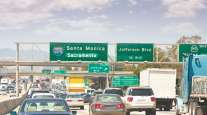DOT, Caltrans Aim to Bring Back Critical Trucking Survey

For transportation planners and thinkers, the Vehicle Inventory and Use Survey was the go-to source for trucking data every five years from 1967 to 2002 as a requirement of the Bureau of the Census. VIUS’ cancellation before the expected 2007 compilation was a major blow. And its proposed return, courtesy of the U.S. Department of Transportation and California’s Department of Transportation, is welcome news.
“VIUS was the basis for getting good truck safety data,” said Darrin Roth, vice president of highway policy for American Trucking Associations. “It got pretty specific. You would see the percentage of 3-axle dump trucks and 4-axle flatbeds. Without VIUS, it’s hard to distinguish a fire truck from a commercial truck. People have been using private sector data, but it’s just not as comprehensive. I think everybody was stunned when VIUS went away. I [had taken] it for granted.”
Roth was far from alone in that, as ATA Chief Economist Bob Costello noted.
“Everyone’s research, from the government to academia to research firms to ATA would be more accurate,” said Costello, who noted that fleets have substantially changed since 2002. “VIUS was frequently used as a benchmark for other research. It has been a critical data loss.”
USDOT hopes to restore VIUS, perhaps on a voluntary basis because its costs had risen from more than $10 million in 2002 to almost $15 million when it was canceled in 2007.
“We should have a clearer idea of possible options … later this year that will better inform the cost for a potential survey to be conducted in the next couple of years,” said Joy Sharp, assistant director for survey programs for the Bureau of Transportation Statistics. “We are hopeful that advances in technology since 2002 have created opportunities to incorporate in-vehicle electronic data collection to augment traditional survey methods.
"New VIUS data would significantly improve the ability to estimate the number of trucks on the highway network, study future transportation growth, evaluate safety risks to highway travelers and assess the energy efficiency and environmental impact of the nation’s truck fleet.”
In the meantime, the ongoing lack of federal data has prompted Caltrans to undertake its own VIUS.
“We have no basic data on a lot of trucking activities in the state of California,” said Doug MacIvor, a senior transportation planner for Caltrans. “We’ve built various transportation models that require the basic information. There’s no way of getting around it: You gotta to have that information.
"We had an idea of what would happen if VIUS went away, but we really didn’t think the feds would do it. We thought they'd smarten up after a while. We kept hoping that Congress would reauthorize VIUS, but they didn’t. It finally got to the point where we couldn’t wait any longer.”
So CalTrans asked the Legislature to fund its own VIUS to the tune of $6.9 million. Pre-test surveys have been sent to trucking companies. Once the questions, which are supposed to take no more than 15 minutes to complete, are tweaked, the actual surveys will be sent in four waves over the course of a year. MacIvor expects to have the results in late 2017 or early 2018.
If USDOT is able to bring back VIUS on a national level, it could be a boon to the trucking industry.
“We think that trucks will be shown in a much more favorable light,” Roth said. “In the last cost allocation study, trucks were paying roughly a third of the money into the Highway Trust Fund. Today that’s over 40%, probably approaching 45%. We pay all kinds of taxes and fees that cars don’t.”


